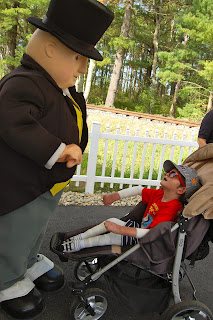We had a long day today. We did Raul's GFR test this morning, and
thankfully I heard tonight that his results were good, which means his
kidneys are functioning well. The test involved injecting a small amount
of radioactive fluid through his central line, and then after 2 hours
his blood was drawn every 40 minutes for several hours
After
rounds I met with Dr. Wagner for Raul's exit conference and to sign all
the consents. This involved going over his results from various tests,
the transplant process, a few additional studies, any potential risks,
and information specific to this BMT protocol. It was actually quite
interesting, and it was nice to learn about the treatment from Dr.
Wagner since he was one of the original doctors who started the trials
for EB. Raul's echo, EKG, chest CT, and labs were all good to continue
on with the transplant process. He does have past exposure to several
viruses that they will need to watch for closely after transplant.
Raul and his donor are full matches, which I was told is not too common
with the EB patients with unrelated donors. They are 8/8 matches with
their HLA typing and also have the same blood type. This should help
reduce the chances of some complications after transplant, and having
the same blood type will help his red blood cells recover more quickly.
We also met briefly again with the pain team, and made a plan for which
pain medicines to try/when to try them. This afternoon we headed back
to the OR for a few more procedures. Unfortunately, the OR was running
two hours behind again, but luckily Raul fell asleep while we waited. He
first had a GI scope, which was surprisingly good! No erosions or major
inflammation, just more mild inflammation in the esophogus and in both
his stomach and esophagus if the camera touched the tissue it bled. They
did note a high stricture, so IR came and did a balloon dilitation of
that next.
After that a PA from the BMT clinic came to do a few
tests for the trial. This involved several tiny skin biopsies on his
thigh, a blister formation test, and photos of his whole body. The
blister test tests how quickly someone makes a blister when it is
induced with a special suction device. Most healthy people would take
around an hour, a carrier may take around 30 minutes, and someone with
EB might take up to 10 minutes (though usually much lower with severe
EB). I asked how long Raul's test had taken, and he said the site began
to blister almost immediately.
Unfortunately, our PACU
experience was not as positive this time. They allowed Raul to wake up
fully before even calling me back to re-bandage him, so he inflicted
some new wounds on himself itching and thrashing and worsened some
current wounds (his entire body was unbandaged). They did finally give
him more medication, but it didn't kick in until I was just about
finished re-doing the bandages. Thankfully I do not think he really
remembers that happening! Tonight he was back to wanting to watch
cartoons, play on his iPad, and eating fruit pouches after a long day of
being NPO!












































